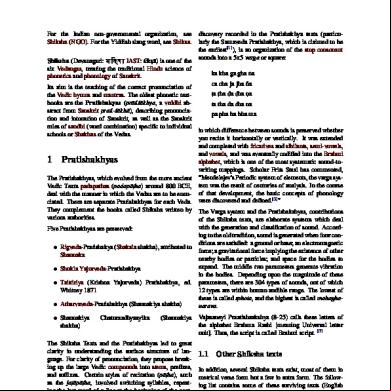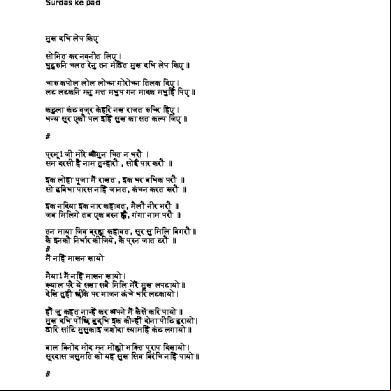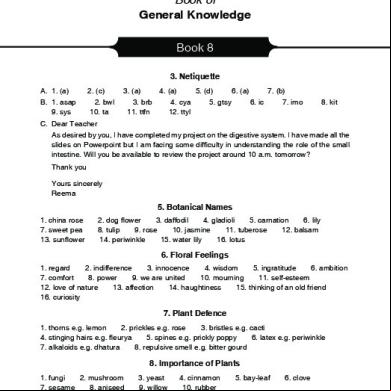Alvars - Vaishnava Poet Saints 4t2nu
This document was ed by and they confirmed that they have the permission to share it. If you are author or own the copyright of this book, please report to us by using this report form. Report 3b7i
Overview 3e4r5l
& View Alvars - Vaishnava Poet Saints as PDF for free.
More details w3441
- Words: 1,757
- Pages: 4
Alvars For the city in Rajasthan, see Alwar. For the village in period of two centuries from the 9th to the 11th cenIran, see Alvars, Iran. tury involving references to religious leaders in Vaishnavism, Shaivism and even Jainism and to political perThe alvars, also spelt as alwars or azhwars (Tamil: sonalities. He states: "āzhvār is but a corrupt form of āļvār which has been used interchangeably with nāyanār ஆழ்வார்கள், āzvārkaḷ [aːɻʋaːr], ‘those immersed in god’) were Tamil poet-saints of South India who espoused in secular and religious contexts in the Tamil land” and "... Notwithstanding the Vaishnava claim of unbroken bhakti (devotion) to the Hindu god Vishnu or his avatar [1] teacher-student tradition, the fact that Nathamuni has Krishna in their songs of longing, ecstasy and service. They are venerated especially in Vaishnavism, which re- used the form āļvār but Piļļān [A disciple and younger cousin of Rāmānuja] ended up using the form āzhvār suggards Vishnu or Krishna as the Supreme Being. gests that there has been an error in transmission someMany modern academics place the Alvars date between where along the teacher-student chain between the two 5th century to 10th century CE, however traditionally the teachers. This error was obviously due to the influence Alvars are considered to have lived between 4200 BCE - of the sound variation that has occurred in the Srirangam 2700 BCE. Orthodoxy posits the number of alvars as ten, area and elsewhere” though there are other references that include Andal and Madhurakavi, making the number twelve.[2] Andal is the only female saint-poet in the 12 Alvars. Together with the contemporary sixty three Shaiva Nayanars, they are 2 Legacy among the most important saints from Tamil Nadu. Alvars are considered the twelve supreme devotees of Vishnu, who were instrumental in popularising Vaishnavism in the Tamil-speaking regions.[8] The religious works of these saints in Tamil, songs of love and devotion, are compiled as Nalayira Divya Prabandham containing 4000 verses and the 108 temples revered in their songs are classified as Divya desam.[9][10] The saints had different origins and belonged to different castes. As per tradition, the first three alvars, Poigai, Bhutha and Pey were born miraculously. Tirumizhisai was the son of a sage; Thondaradi, Mathurakavi, Peria and Andal were from brahmin caste; Kulasekhara was a Kshatria, Namm was from a cultivator family, Tirupana from panar community and Tirumangai from kazhwar community. Divya Suri Saritra by Garuda-Vahana Pandita (11th century), Guruparamparaprabavam by Pinbaragiya Perumal Jiyar, Periya tiru mudi adaivu by Anbillai Kandadiappan, Yatindra Pranava Prabavam by Pillai Lokacharya, commentaries on Divya Prabandam, Guru Parampara (lineage of Gurus) texts, temple records and inscriptions give a detailed of the alavars and their works. According to these texts, the saints were considered incarnations 1 Etymology of some form of Vishnu. The songs of Prabandam are temples of South India Alvars literally means 'people who are immersed'. They regularly sung in all the Vishnu [10][11] daily and also during festivals. are so called because they were immersed in their devotion and love to their Lord, Vishnu.[6] However recently It is widely accepted by tradition and historians alike S.Palaniappan has argued that what was originally Āļvār that the first three alvars, Poigai, Bhutha and Pey, are got changed through hyper correction and folk etymol- the earliest among the twelve alvars.[9][10][12][13][14] Along ogy to Āzhvār.[7] Palaniappan cites inscriptional evidence with the 63 Shaiva nayanars, they influenced the ruling for a gradual sound change from āļvār to āzhvār over a Pallava kings, creating a Bhakti movement that resulted The devotional outpourings of Alvars, composed during the early medieval period of Tamil history, helped revive the bhakti movement, through their hymns of worship to Vishnu and his avatars. They praised the Divya Desams, 108 “abodes” (temples) of these Vaishnava deities. The poetry of the Alvars echoes bhakti to God through love, and in the ecstasy of such devotions they sang hundreds of songs which embodied both depth of feeling and felicity of expressions.[3] The collection of their hymns is known as Divya Prabandha. The Bhakti literature that sprang from Alvars has contributed to the establishment and sustenance of a culture that broke away from the ritual-oriented Vedic religion and rooted itself in devotion as the only path for salvation. In addition they helped to make the Tamil religious life independent of a knowledge of Sanskrit.[4] As part of the legacy of the Alvars, five Vaishnava philosophical traditions (sampradayas) have developed at the later stages.[5]
1
2
5 NOTES
in changing the religious geography from Buddhism and Jainism to these two sects of Hinduism in the region. The alvars were also instrumental in promoting the Bhagavata cult and the two Hindu epics, namely, Ramayana and Mahabaratha.[15] The verses of the various azhwars were compiled by Nathamuni (824 - 924 AD), a 10th-century Vaishnavite theologian, who called it the “Dravida Veda”.[16][17]
3
Summary
Some modern scholars suggest that they lived during 5th - 9th century CE, “on the basis of a few historical evidences”, although no “clear” evidence exists.[18][19] The Encyclopædia Britannica says that Alvars lived between 7th-10th century CE.[20] Professor of Religion and Asian Studies, James G. Lochtefeld of Carthage College, notes in his The Illustrated Encyclopedia of Hinduism, the first three Alvars Poigai, Bhoothath and Pey belonged to the 7th century; while Nammalvar and Madhurakavi belonged to the 10th century; while rest of them lived in the 9th century.[21]
[6] "Meaning of Alvar". ramanuja.org. Retrieved 2007-0702. [7] Alvar or Nayanar : The Role of Sound Variation, Hypercorrection and Folk Etymology in Interpreting the Nature of Vaisnava Saint-Poets (PDF). South-Indian Horizons, Institut Francais de Pondichéry (French Institute of Pondicherry). 2005. [8] B.S. 2011, p. 47-48 [9] Rao, P.V.L. Narasimha (2008). Kanchipuram – Land of Legends, Saints & Temples. New Delhi: Readworthy Publications (P) Ltd. p. 27. ISBN 978-93-5018-104-1. [10] Dalal 2011, pp. 20-21 [11] Ramaswamy, Vijaya (2007). Historical Dictionary of the Tamils. Scarecrow Press. p. 211. ISBN 9780810864450. [12] Aiyangar, Sakkottai Krishnaswami (1920). Early history of Vaishnavism in south India. Oxford University Press. pp. 17–18. [13] Lochtefeld, James (2002). The Illustrated Encyclopedia of Hinduism: N-Z. The Rosen Publishing Group. p. 515. ISBN 9780823931804. [14] Krishna (2009). Book Of Vishnu. Penguin Books India.
Traditionally the Alvars are considered to have lived bep. 136. ISBN 9780143067627. tween 4200 BCE - 2700 BCE.[22][23] Traditional dates take them to the age of Shuka from the period of the [15] B.S. 2011, p. 42 Bhagavata Purana, many are from Dwaparayuga, while [16] Mukherjee (1999). A Dictionary of Indian Literatures: Nammalwar belongs to the early part of Kaliyuga.[24] Beginnings-1850 Volume 1 of A Dictionary of Indian Lit-
erature, A Dictionary of Indian Literature. Orient BlackThe following table shows the place, century and star swan. p. 15. ISBN 9788125014539. of birth of each Alvar. Scholarly dating is based on summary of views of modern scholars by Dr. N Subba [17] Garg, Gaṅgā Rām (1992). Encyclopaedia of the Hindu Reddiar.[18] World: Ak-Aq. Concept Publishing Company. pp. 352– 354. ISBN 9788170223757.
4
See also • Bhakti movements • Tamil mythology • Nathamuni
5
Notes
[1] Andrea Nippard. “The Alvars” (PDF). Retrieved 201304-20. [2] Flood 1996, p. 131 [3] “Indian Literature Through the Ages”. Indian literature , Govt of India. Retrieved 2013-04-20.
[18] "Philosophy and Theistic Mysticism of the Āl ̲vārs", by S. M. Srinivasa Chari, publisher = Motilal Banarsidass, isbn = 9788120813427, p. 11 [19] “Mādhavêndra Purī: A Link between Bengal Vaiṣṇavism and South Indian “Bhakti”, by Friedhelm HardyThe Journal of the Royal Asiatic Society of Great Britain and Ireland No. 1 (1974), pp. 23-41, Published by: Cambridge University Press, URL: http://www.jstor.org/ stable/25203503 [20] “Azhvar”. Encyclopædia Britannica. Encyclopædia Britannica Online. Encyclopædia Britannica Inc., 2014. Web. 30 Dec. 2014
. [21] James G. Lochtefeld (2002). The Illustrated Encyclopedia of Hinduism: A-M. The Rosen Publishing Group. pp. 29– 30. ISBN 978-0-8239-3179-8.
[4] "About Alvars". divyadesamonline.com. Archived from the original on 2007-06-21. Retrieved 2007-07-02.
[22] "Philosophy and Theistic Mysticism of the Āl ̲vārs", by S. M. Srinivasa Chari, publisher = Motilal Banarsidass, isbn = 9788120813427, p. 10
[5] Mittal, S. G. R.; Thursby (2006). Religions of South Asia: An Introduction. Routledge. p. 27. ISBN 9780203970027.
[23] "Śrībhāṣyam: Catuḥsūtryātmakaḥ", by Rāmānuja, Raghunath Damodar Karmarkar, p.18, original from = The University of Michigan
3
[24] Jean Filliozat. Religion, Philosophy, Yoga: A Selection of Articles. Motilal Banarsidass. p. 23. [25] "Ancient India: Collected Essays on the Literary and Political History of Southern India", by Sakkottai Krishnaswami Aiyangar, p. 403-404, publisher = Asian Educational Services [26] “Music and temples, a ritualistic approach”, by L. Annapoorna, p. 23, year = 2000, isbn = 9788175740907 [27] "History of Classical Sanskrit Literature", by M. Srinivasachariar, p. 278, isbn=9788120802841
6
References • Flood, G.D. (1996). An Introduction to Hinduism. Cambridge University Press. • Hymns For The Drowning by A.K. Ramanujan (Penguin),
Nammalvar by A.Srinivasa Raghavan (Sahitya Akademi, New Delhi),1975, ISBN 81-260-0416 9 Alwargal - ^Or Eliya Arimugam by Sujatha (Visa Publications, Chennai, India)(in Tamil), 2001
7
External links • The Twelve Alvars • Alvars and Srivaishnavism • The Alvar Saints (ramanuja.org) • The Alvar Saints of Tamilnadu by Jyotsna Kamat
4
8 TEXT AND IMAGE SOURCES, CONTRIBUTORS, AND LICENSES
8
Text and image sources, contributors, and licenses
8.1
Text
• Alvars Source: http://en.wikipedia.org/wiki/Alvars?oldid=660028567 Contributors: Carlossuarez46, Shash, Seano1, Vishvas vasuki, Utcursch, Profvk, Venu62, Discospinster, Rich Farmbrough, Alren, Kwamikagami, Raj2004, Samsudar, Wiki-uk, Woohookitty, Dangerous-Boy, Pranathi, Rjwilmsi, SMC, Bgwhite, DanMS, Srini81, Natkeeran, Priyanath, SmackBot, SundarBot, BostonMA, WarrenA, GourangaUK, Nishkid64, Kanatonian, DumbBOT, DBaba, Thbaskaran, Escarbot, MECU, Bakasuprman, Hawkeye26, Magioladitis, Kajasudhakarababu, Pataps, Piggy bits, Lifebonzza, KylieTastic, MartinBotIII, Redtigerxyz, VolkovBot, TXiKiBoT, Buddhipriya, Mythri achar, Eubulides, Balaji Sundararaman, Oldag07, Nummer29, The Evil Spartan, CultureDrone, MenoBot, Shruti14, Mild Bill Hiccup, Ssriram mt, Alexbot, Pavasantha, SchreiberBike, WikiJedits, SoxBot III, Editor2020, Wikidas, Thistorian, Ism schism, Addbot, Redheylin, Favonian, Vyom25, Yobot, Pnramchandran, FrescoBot, Vraghava, HRoestBot, Dazedbythebell, Xadhix, Vprashanth87, John of Reading, WikitanvirBot, Gurumoorthy Poochandhai, Kkm010, H3llBot, Vanished qwqwijr8hwrkjdnvkanfoh4, Dr.raghav, Rocketrod1960, Sarathy writes, Lawpark00, AngusWOOF, NotWith, ChrisGualtieri, Rockin It Loud, BrightStarSky, JnanaKarma, 069952497a, Eshwar.om, Bladesmulti, Filedelinkerbot, Iṣṭa Devatā, Aksha99 and Anonymous: 54
8.2
Images
• File:6.jpg Source: http://.wikimedia.org/wikipedia/commons/1/18/6.jpg License: CC BY 2.0 Contributors: 6 Original artist: Tim Lloyd from Chester, England • File:HinduSwastika.svg Source: http://.wikimedia.org/wikipedia/commons/6/63/HinduSwastika.svg License: Public domain Contributors: ? Original artist: ? • File:Nammazhwar.jpg Source: http://.wikimedia.org/wikipedia/commons/9/9a/Nammazhwar.jpg License: Public domain Contributors: Own work Original artist: Sudharsan2020 • File:Om.svg Source: http://.wikimedia.org/wikipedia/en/8/8e/Om.svg License: PD Contributors: svg created by Rugby471 from a public domain symbol Original artist: Rugby471 • File:The_Saint_Andal_LACMA_M.86.94.2.jpg Source: http://.wikimedia.org/wikipedia/commons/2/25/The_Saint_Andal_ LACMA_M.86.94.2.jpg License: Public domain Contributors: • Image: http://collections.lacma.org/sites/default/files/remote_images/piction/ma-31972448-O3.jpg Original artist: ? • File:Thiruppan.jpg Source: http://.wikimedia.org/wikipedia/commons/0/0b/Thiruppan.jpg License: Public domain Contributors: Own work Original artist: ?
8.3
Content license
• Creative Commons Attribution-Share Alike 3.0
1
2
5 NOTES
in changing the religious geography from Buddhism and Jainism to these two sects of Hinduism in the region. The alvars were also instrumental in promoting the Bhagavata cult and the two Hindu epics, namely, Ramayana and Mahabaratha.[15] The verses of the various azhwars were compiled by Nathamuni (824 - 924 AD), a 10th-century Vaishnavite theologian, who called it the “Dravida Veda”.[16][17]
3
Summary
Some modern scholars suggest that they lived during 5th - 9th century CE, “on the basis of a few historical evidences”, although no “clear” evidence exists.[18][19] The Encyclopædia Britannica says that Alvars lived between 7th-10th century CE.[20] Professor of Religion and Asian Studies, James G. Lochtefeld of Carthage College, notes in his The Illustrated Encyclopedia of Hinduism, the first three Alvars Poigai, Bhoothath and Pey belonged to the 7th century; while Nammalvar and Madhurakavi belonged to the 10th century; while rest of them lived in the 9th century.[21]
[6] "Meaning of Alvar". ramanuja.org. Retrieved 2007-0702. [7] Alvar or Nayanar : The Role of Sound Variation, Hypercorrection and Folk Etymology in Interpreting the Nature of Vaisnava Saint-Poets (PDF). South-Indian Horizons, Institut Francais de Pondichéry (French Institute of Pondicherry). 2005. [8] B.S. 2011, p. 47-48 [9] Rao, P.V.L. Narasimha (2008). Kanchipuram – Land of Legends, Saints & Temples. New Delhi: Readworthy Publications (P) Ltd. p. 27. ISBN 978-93-5018-104-1. [10] Dalal 2011, pp. 20-21 [11] Ramaswamy, Vijaya (2007). Historical Dictionary of the Tamils. Scarecrow Press. p. 211. ISBN 9780810864450. [12] Aiyangar, Sakkottai Krishnaswami (1920). Early history of Vaishnavism in south India. Oxford University Press. pp. 17–18. [13] Lochtefeld, James (2002). The Illustrated Encyclopedia of Hinduism: N-Z. The Rosen Publishing Group. p. 515. ISBN 9780823931804. [14] Krishna (2009). Book Of Vishnu. Penguin Books India.
Traditionally the Alvars are considered to have lived bep. 136. ISBN 9780143067627. tween 4200 BCE - 2700 BCE.[22][23] Traditional dates take them to the age of Shuka from the period of the [15] B.S. 2011, p. 42 Bhagavata Purana, many are from Dwaparayuga, while [16] Mukherjee (1999). A Dictionary of Indian Literatures: Nammalwar belongs to the early part of Kaliyuga.[24] Beginnings-1850 Volume 1 of A Dictionary of Indian Lit-
erature, A Dictionary of Indian Literature. Orient BlackThe following table shows the place, century and star swan. p. 15. ISBN 9788125014539. of birth of each Alvar. Scholarly dating is based on summary of views of modern scholars by Dr. N Subba [17] Garg, Gaṅgā Rām (1992). Encyclopaedia of the Hindu Reddiar.[18] World: Ak-Aq. Concept Publishing Company. pp. 352– 354. ISBN 9788170223757.
4
See also • Bhakti movements • Tamil mythology • Nathamuni
5
Notes
[1] Andrea Nippard. “The Alvars” (PDF). Retrieved 201304-20. [2] Flood 1996, p. 131 [3] “Indian Literature Through the Ages”. Indian literature , Govt of India. Retrieved 2013-04-20.
[18] "Philosophy and Theistic Mysticism of the Āl ̲vārs", by S. M. Srinivasa Chari, publisher = Motilal Banarsidass, isbn = 9788120813427, p. 11 [19] “Mādhavêndra Purī: A Link between Bengal Vaiṣṇavism and South Indian “Bhakti”, by Friedhelm HardyThe Journal of the Royal Asiatic Society of Great Britain and Ireland No. 1 (1974), pp. 23-41, Published by: Cambridge University Press, URL: http://www.jstor.org/ stable/25203503 [20] “Azhvar”. Encyclopædia Britannica. Encyclopædia Britannica Online. Encyclopædia Britannica Inc., 2014. Web. 30 Dec. 2014
[4] "About Alvars". divyadesamonline.com. Archived from the original on 2007-06-21. Retrieved 2007-07-02.
[22] "Philosophy and Theistic Mysticism of the Āl ̲vārs", by S. M. Srinivasa Chari, publisher = Motilal Banarsidass, isbn = 9788120813427, p. 10
[5] Mittal, S. G. R.; Thursby (2006). Religions of South Asia: An Introduction. Routledge. p. 27. ISBN 9780203970027.
[23] "Śrībhāṣyam: Catuḥsūtryātmakaḥ", by Rāmānuja, Raghunath Damodar Karmarkar, p.18, original from = The University of Michigan
3
[24] Jean Filliozat. Religion, Philosophy, Yoga: A Selection of Articles. Motilal Banarsidass. p. 23. [25] "Ancient India: Collected Essays on the Literary and Political History of Southern India", by Sakkottai Krishnaswami Aiyangar, p. 403-404, publisher = Asian Educational Services [26] “Music and temples, a ritualistic approach”, by L. Annapoorna, p. 23, year = 2000, isbn = 9788175740907 [27] "History of Classical Sanskrit Literature", by M. Srinivasachariar, p. 278, isbn=9788120802841
6
References • Flood, G.D. (1996). An Introduction to Hinduism. Cambridge University Press. • Hymns For The Drowning by A.K. Ramanujan (Penguin),
Nammalvar by A.Srinivasa Raghavan (Sahitya Akademi, New Delhi),1975, ISBN 81-260-0416 9 Alwargal - ^Or Eliya Arimugam by Sujatha (Visa Publications, Chennai, India)(in Tamil), 2001
7
External links • The Twelve Alvars • Alvars and Srivaishnavism • The Alvar Saints (ramanuja.org) • The Alvar Saints of Tamilnadu by Jyotsna Kamat
4
8 TEXT AND IMAGE SOURCES, CONTRIBUTORS, AND LICENSES
8
Text and image sources, contributors, and licenses
8.1
Text
• Alvars Source: http://en.wikipedia.org/wiki/Alvars?oldid=660028567 Contributors: Carlossuarez46, Shash, Seano1, Vishvas vasuki, Utcursch, Profvk, Venu62, Discospinster, Rich Farmbrough, Alren, Kwamikagami, Raj2004, Samsudar, Wiki-uk, Woohookitty, Dangerous-Boy, Pranathi, Rjwilmsi, SMC, Bgwhite, DanMS, Srini81, Natkeeran, Priyanath, SmackBot, SundarBot, BostonMA, WarrenA, GourangaUK, Nishkid64, Kanatonian, DumbBOT, DBaba, Thbaskaran, Escarbot, MECU, Bakasuprman, Hawkeye26, Magioladitis, Kajasudhakarababu, Pataps, Piggy bits, Lifebonzza, KylieTastic, MartinBotIII, Redtigerxyz, VolkovBot, TXiKiBoT, Buddhipriya, Mythri achar, Eubulides, Balaji Sundararaman, Oldag07, Nummer29, The Evil Spartan, CultureDrone, MenoBot, Shruti14, Mild Bill Hiccup, Ssriram mt, Alexbot, Pavasantha, SchreiberBike, WikiJedits, SoxBot III, Editor2020, Wikidas, Thistorian, Ism schism, Addbot, Redheylin, Favonian, Vyom25, Yobot, Pnramchandran, FrescoBot, Vraghava, HRoestBot, Dazedbythebell, Xadhix, Vprashanth87, John of Reading, WikitanvirBot, Gurumoorthy Poochandhai, Kkm010, H3llBot, Vanished qwqwijr8hwrkjdnvkanfoh4, Dr.raghav, Rocketrod1960, Sarathy writes, Lawpark00, AngusWOOF, NotWith, ChrisGualtieri, Rockin It Loud, BrightStarSky, JnanaKarma, 069952497a, Eshwar.om, Bladesmulti, Filedelinkerbot, Iṣṭa Devatā, Aksha99 and Anonymous: 54
8.2
Images
• File:6.jpg Source: http://.wikimedia.org/wikipedia/commons/1/18/6.jpg License: CC BY 2.0 Contributors: 6 Original artist: Tim Lloyd from Chester, England • File:HinduSwastika.svg Source: http://.wikimedia.org/wikipedia/commons/6/63/HinduSwastika.svg License: Public domain Contributors: ? Original artist: ? • File:Nammazhwar.jpg Source: http://.wikimedia.org/wikipedia/commons/9/9a/Nammazhwar.jpg License: Public domain Contributors: Own work Original artist: Sudharsan2020 • File:Om.svg Source: http://.wikimedia.org/wikipedia/en/8/8e/Om.svg License: PD Contributors: svg created by Rugby471 from a public domain symbol Original artist: Rugby471 • File:The_Saint_Andal_LACMA_M.86.94.2.jpg Source: http://.wikimedia.org/wikipedia/commons/2/25/The_Saint_Andal_ LACMA_M.86.94.2.jpg License: Public domain Contributors: • Image: http://collections.lacma.org/sites/default/files/remote_images/piction/ma-31972448-O3.jpg Original artist: ? • File:Thiruppan.jpg Source: http://.wikimedia.org/wikipedia/commons/0/0b/Thiruppan.jpg License: Public domain Contributors: Own work Original artist: ?
8.3
Content license
• Creative Commons Attribution-Share Alike 3.0










